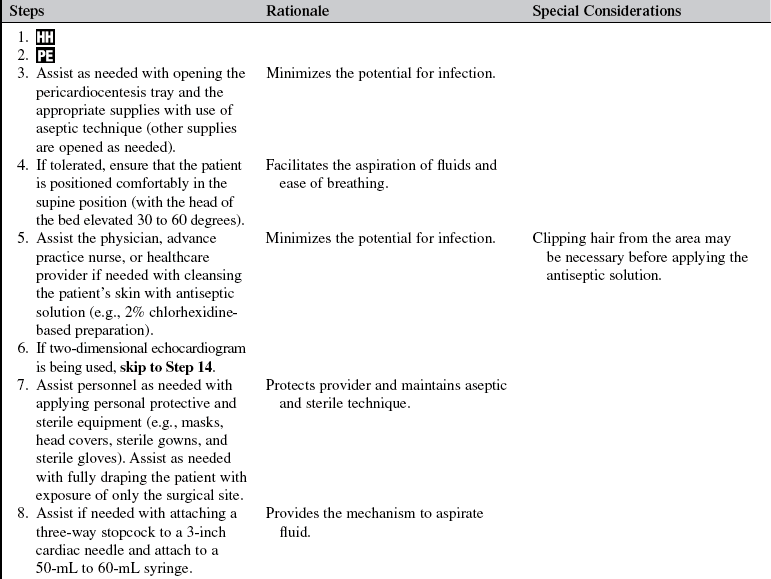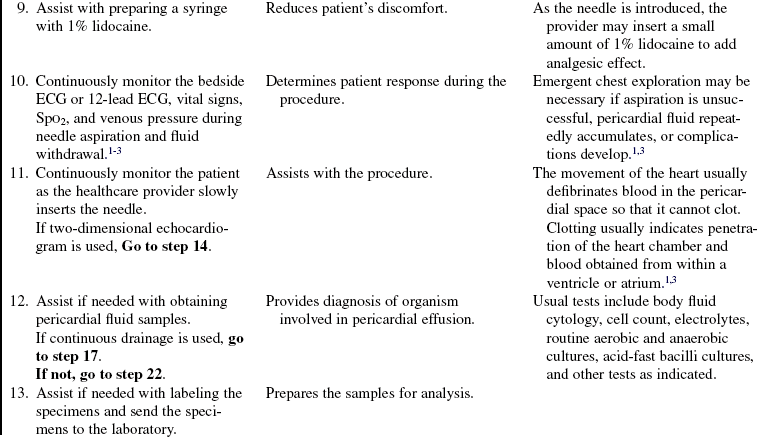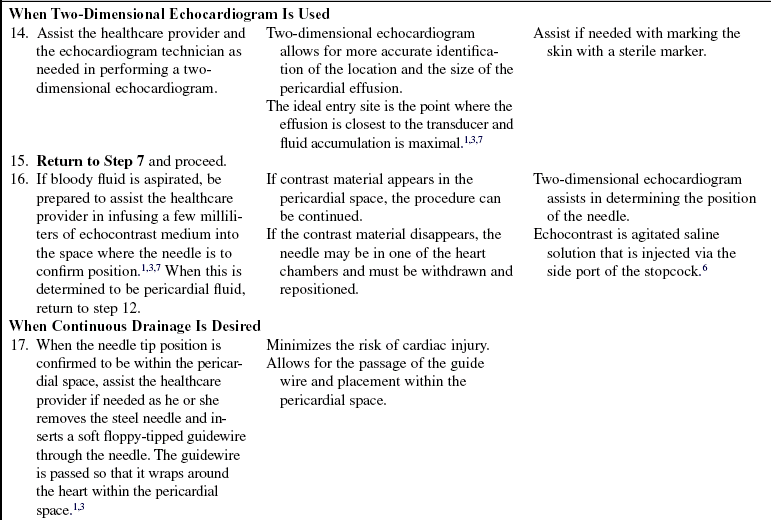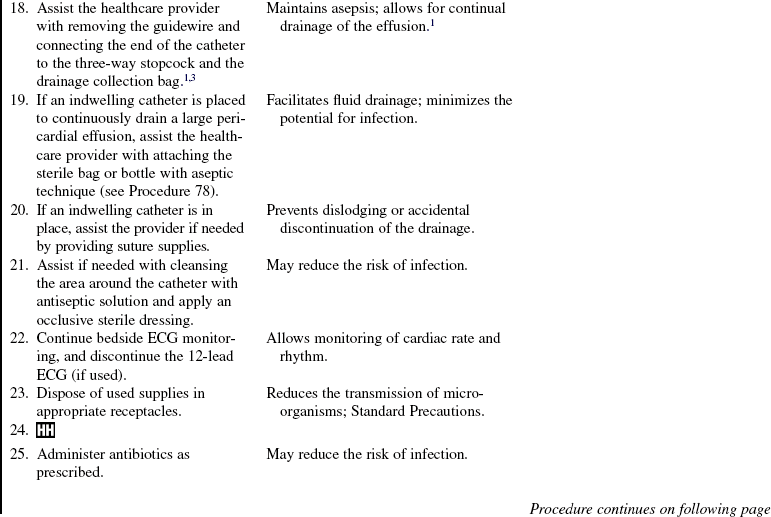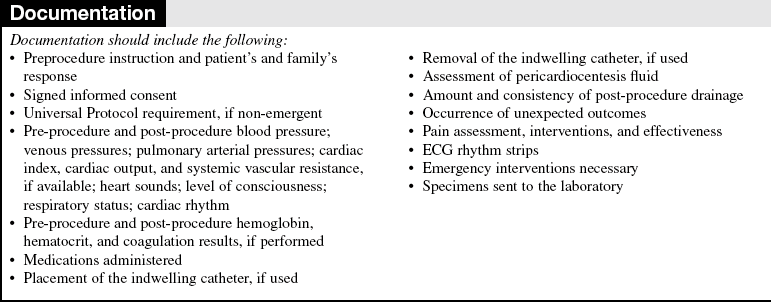Pericardiocentesis (Assist)
PREREQUISITE NURSING KNOWLEDGE
• Advanced cardiac life support knowledge and skills are needed.
• Knowledge of sterile technique is necessary.
• Knowledge of cardiovascular anatomy and physiology is needed.
• Pericardial effusion is the abnormal accumulation of greater than 50 mL of serosanguineous fluid within the pericardial sac.
• A pericardial effusion can be noncompressive or compressive. With a compressive effusion, increased pressure is found within the pericardial sac, which may result in cardiac tamponade and resistance to cardiac filling.
• The presentation of acute and chronic fluid accumulation varies. A rapid collection of fluid (over minutes to hours) may result in hemodynamic compromise with volumes of less than 250 mL. Chronically developing effusions (over days to weeks) allow for hypertrophy and distention of the fibrous parietal membrane.2 Patients with chronic effusions may accumulate greater than or equal to 2000 mL of fluid before exhibiting symptoms of hemodynamic compromise.1,2
• Symptoms of cardiac tamponade are not specific. Patients may have signs and symptoms of an associated disease. With a decrease in cardiac output, the patient often has development of tachycardia, tachypnea, pallor, cyanosis, impaired cerebral and renal function, sweating, hypotension, neck vein distention, distant or faint heart sounds, and pulsus paradoxus.1–3
• The amount of fluid in the pericardium is evaluated through chest radiograph, two-dimensional echocardiogram, and clinical findings.
• When cardiac tamponade or a large enough effusion to warrant drainage is verified, a pericardiocentesis is performed to remove fluid from the pericardial sac. An acute tamponade that results in hemodynamic instability necessitates an emergency procedure. Blind pericardiocentesis should be performed only in extreme emergency situations. The use of electrocardiographic (ECG) monitoring from the needle tip with an alligator clip is not recommended.4
• Pericardiocentesis commonly is performed via a subxiphoid approach.
• Two-dimensional echocardiography is recommended to assist in guiding the needle during the pericardiocentesis.7
• This procedure may be performed in the cardiac catheterization laboratory with fluroscopy.
• Inability to obtain pericardial drainage, reaccumulation of pericardial fluid, or cardiac injury may progress into cardiac tamponade that necessitates urgent or emergent chest exploration.
EQUIPMENT
• Pericardiocentesis tray (or thoracentesis tray)
• 16-gauge or 18-gauge, 3-inch cardiac needle or catheter over the needle
• Antiseptic solution (e.g., 2% chlorhexidine-based preparation)
• Two packs of 4 × 4 gauze sponges
• No. 11 knife blade with handle (scalpel)
• Sterile 50-mL to 60-mL, 10-mL, 5-mL, and 3-mL syringes
• Masks, goggles or face shields, surgical head covers, sterile gowns, and gloves for all personnel
PATIENT AND FAMILY EDUCATION
• Instruct the patient and family regarding the reason the pericardiocentesis is needed; describe the procedure; and explain the expected outcomes, alternatives, and possible complications.  Rationale: This communication helps the patient and family to understand the procedure. Information about the procedure reduces anxiety and apprehension.
Rationale: This communication helps the patient and family to understand the procedure. Information about the procedure reduces anxiety and apprehension.
• Instruct the patient and family about potential signs and symptoms of recurrent pericardial effusion (e.g., dyspnea, dull ache or pressure within the chest, dysphagia, cough, tachypnea, hoarseness, hiccups, or nausea).2,3  Rationale: Early detection of pericardial effusion may prevent complications from cardiac compression.
Rationale: Early detection of pericardial effusion may prevent complications from cardiac compression.
• Instruct the patient and family about the patient’s risk for recurrent pericardial effusion.  Rationale: Prediction of pericardial effusion may allow early detection of a potentially life-threatening problem.
Rationale: Prediction of pericardial effusion may allow early detection of a potentially life-threatening problem.
PATIENT ASSESSMENT AND PREPARATION
Patient Assessment
• Determine the history of the present illness and mechanism of injury (if applicable), medical history, and current medical therapies.  Rationale: The history is needed to determine the patient’s present health, to identify potential risk factors, and to provide an opportunity for the nurse to establish a relationship with the patient.
Rationale: The history is needed to determine the patient’s present health, to identify potential risk factors, and to provide an opportunity for the nurse to establish a relationship with the patient.
• Assess the patient’s heart rate, cardiac rhythm, heart sounds (S1, S2, rubs), venous pressure (noninvasive or invasive), blood pressure, pulse pressure, oxygen saturation with pulse oximetry (SpO2), respiratory status, and neurologic status.  Rationale: These data are needed to compare baseline data to assess for changes during or after the procedure.
Rationale: These data are needed to compare baseline data to assess for changes during or after the procedure.
• Assess the current laboratory values, including the complete blood cell count, electrolyte levels, and coagulation profile.  Rationale: These data are needed to identify the potential for cardiac dysrhythmias or abnormal bleeding. If the international normalized ratio or partial thromboplastin time or both are elevated, the level of anticoagulation therapy may be reversed before the procedure or the procedure may be deferred until the levels indicate a reduced possibility of bleeding.
Rationale: These data are needed to identify the potential for cardiac dysrhythmias or abnormal bleeding. If the international normalized ratio or partial thromboplastin time or both are elevated, the level of anticoagulation therapy may be reversed before the procedure or the procedure may be deferred until the levels indicate a reduced possibility of bleeding.
Patient Preparation
• Ensure that the patient and family understand pre-procedural teachings. Answer questions as they arise, and reinforce information as needed.  Rationale: This communication evaluates and reinforces understanding of previously taught information.
Rationale: This communication evaluates and reinforces understanding of previously taught information.
• Verify correct patient with two identifiers.  Rationale: Prior to performing a procedure, the nurse should ensure the correct identification of the patient for the intended intervention.
Rationale: Prior to performing a procedure, the nurse should ensure the correct identification of the patient for the intended intervention.
• Ensure that informed consent is obtained.  Rationale: Informed consent protects the rights of the patient and makes competent decision making possible for the patient; however, in emergency circumstances, time may not allow for the consent form to be signed.
Rationale: Informed consent protects the rights of the patient and makes competent decision making possible for the patient; however, in emergency circumstances, time may not allow for the consent form to be signed.
• Perform a pre-procedure verification and time out, if non-emergent.  Rationale: Ensures patient safety.
Rationale: Ensures patient safety.
• Assist if needed with coordinating the procedure with the echocardiogram technician if the two-dimensional echocardiogram approach will be used.  Rationale: The echocardiogram technician locates the fluid accumulation, which makes performing the pericardiocentesis easier for the provider.1,2,6
Rationale: The echocardiogram technician locates the fluid accumulation, which makes performing the pericardiocentesis easier for the provider.1,2,6
• If tolerated, position the patient comfortably in the supine position with the head of bed elevated 30 to 60 degrees.  Rationale: The supine position facilitates aspiration of pericardial fluids and ease of breathing.
Rationale: The supine position facilitates aspiration of pericardial fluids and ease of breathing.
• Administer analgesics or sedatives as prescribed.  Rationale: Analgesia and sedation reduce anxiety and promote comfort.
Rationale: Analgesia and sedation reduce anxiety and promote comfort.
• Apply the limb leads and connect the patient to the cardiac bedside monitoring system or to the 12-lead ECG machine.  Rationale: The ECG is analyzed during and after the procedure to monitor the patient for changes that may indicate cardiac injury.
Rationale: The ECG is analyzed during and after the procedure to monitor the patient for changes that may indicate cardiac injury.
References
1. Becker, RC. Pericardiocentesis. In Irwin RS, et al, eds. : Procedures and techniques in intensive care medicine,, ed 6, Philadelphia: Lippincott Williams & Wilkins, 2008.
![]() 2. Belenkie, I. Pericardial disease. In Hall JB, et al, eds. : Principles of critical care,, ed 3, Quebec: McGraw-Hill, 2005.
2. Belenkie, I. Pericardial disease. In Hall JB, et al, eds. : Principles of critical care,, ed 3, Quebec: McGraw-Hill, 2005.
![]() 3. Harper, RJ. Pericardiocentesis. In Roberts JR, et al, eds. : Clinical procedures in emergency medicine,, ed 4, Philadelphia: Elsevier, 2004.
3. Harper, RJ. Pericardiocentesis. In Roberts JR, et al, eds. : Clinical procedures in emergency medicine,, ed 4, Philadelphia: Elsevier, 2004.
![]() 4. Hoit, BD. Management of effusive and constrictive pericardial heart disease. Circulation. 2002; 105:2939–2942.
4. Hoit, BD. Management of effusive and constrictive pericardial heart disease. Circulation. 2002; 105:2939–2942.
![]() 5. O’Grady, NP, et al. Guidelines for the prevention of intravascular catheter-related infections. Am J Infect Control. 2002; 30(8):476–489.
5. O’Grady, NP, et al. Guidelines for the prevention of intravascular catheter-related infections. Am J Infect Control. 2002; 30(8):476–489.
![]() 6. Rifkin, RD, Mernoff, DB. Noninvasive evaluation of pericardial effusion composition by computed tomography. Am Heart J. 2005; 149:1120–1127.
6. Rifkin, RD, Mernoff, DB. Noninvasive evaluation of pericardial effusion composition by computed tomography. Am Heart J. 2005; 149:1120–1127.
![]() 7. Tsang, TS, et al, Echocardiographically guided pericardiocentesis. evolution and state-of-the-art technique. Mayo Clin Proc 1998; 73:647–652.
7. Tsang, TS, et al, Echocardiographically guided pericardiocentesis. evolution and state-of-the-art technique. Mayo Clin Proc 1998; 73:647–652.
Kuhn, B, Peters, J, Marx, GR, et al. Etiology, management and outcome of pediatric pericardial effusions. Pediatr Cardiol. 2008; 29:90–94.
![]() Mavroukakis, S, Stine, A. Nursing management of adults with disorders of the coronary arteries, myocardium, or pericardium. In: Beare PG, Myers JL, eds. Adult health nursing. St Louis: Mosby, 1998.
Mavroukakis, S, Stine, A. Nursing management of adults with disorders of the coronary arteries, myocardium, or pericardium. In: Beare PG, Myers JL, eds. Adult health nursing. St Louis: Mosby, 1998.






